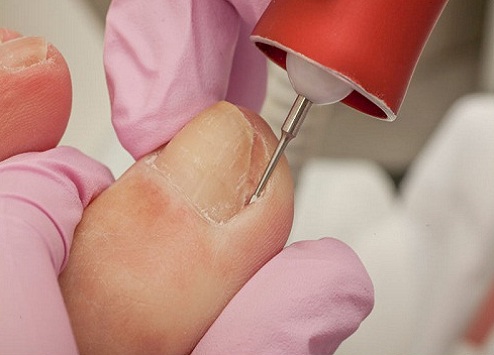
Fungal nail infection worsens this condition and makes the toenail to widen and thicken. People with diabetes and other severe health conditions can have a complication in their blood flow around their feet. Diabetes can affect toenail healing capacity; in such a case or condition, the patient must seek early medical assistance. Diabetic people are also at a higher risk to develop or suffer from ingrown toenails.
Symptoms of an ingrown toenail
• Pain, redness, inflammation, and tenderness in the toe and the surrounding toenail area
• Edema in the toe area
• Infection and bleeding in the skin tissue present around the toenail
• Hypertrophy (skin overgrowth) in the affected toe area
• Pus (yellow or white) coming out from the infected area
Causes of ingrown toenails?
• Incorrect cutting of the toenails (cutting the toenail edges and cutting the toenails very short). This encourages the nail to grow into the skin and also causes skin folding over the nail.
• Injury to the toenail
• Irregular, curved toenails
• Wearing tight shoes (shoes that are too narrow, or flat for the feet) and footwear that cause pressure on the toenails
• Lack of foot hygiene (not keeping the feet dry and clean)
• Sweaty feet make the toenail skin soft, and this makes it easy for the nail to pierce and embed itself inside the skin
People with ingrown nails must not pick their toes and toenails or try to cut the toenail. They may let it grow out. Ingrown toenails can cause pain, fever, difficulty in walking, and perform other activities. It can also lead to further infection.
Over the counter medications, antibiotics, and to prevent infection.
Left untreated ingrown nails can become infected, and surgery is recommended to improve the toenail condition. The dermatologist depending upon the severity of the condition and symptoms may remove some part or all part of the toenail.
Ways to prevent ingrown toenails
Change socks regularly and always wear cotton socks
Wear comfortable shoes and keep the feet and nails clean by washing them regularly with water and antimicrobial soap, then dry them thoroughly, and apply foot moisturizer
Toenails must be cut properly (straight across manner), this prevents them from digging into the surrounding skin tissues
Types of toenail correction surgery
1. Total Nail Avulsion
In this method, the entire toenail and the underlying nail bed is removed. It is performed when the nail has become thick or distorted and is pressing the surrounding toe skin. Removing toenail is completely safe, and there will be an indentation in the toenail area. The toe is wrapped with sterile bandages to provide protection from infection and stop bleeding. The patient must give rest to their foot, and keep it raised for 24 to 48 hours after the operation. Painkiller is provided to reduce pain.
2. Partial Nail Avulsion
This procedure is very much effective in treating ingrown toenails, and a local anaesthetic is used to numb the area, and toenail edges are removed to make it narrower. The pus is also drained, and phenol or laser is applied in the affected area. This prevents the nail from becoming ingrown toenail in the future. The antibiotics are also prescribed if the nail is infected, and the treatment area is bandaged. The patient must take proper rest to promote early healing. After the surgical treatment, the patient needs to wear soft and spacious footwear and open-toed sandals. After some time, the nails grow back. The doctor places a cotton piece on the nail, and it helps in preventing the nails from digging into the skin again.
© theskincentresirsa.com, All Right Reserved.
Designed By Camsol India